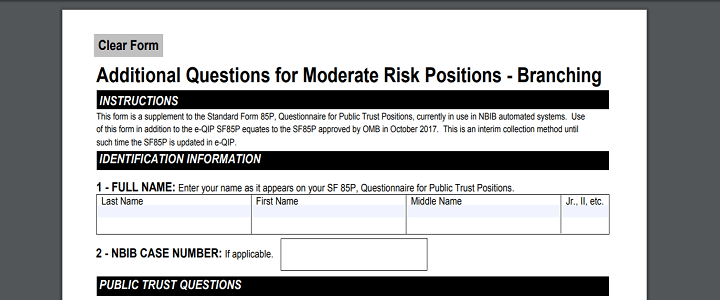Over a year ago investigators working for the Office of Personnel Management’s (OPM) National Background Investigations Bureau (NBIB) began asking 28 additional questions during Enhanced Subject Interviews (ESIs) for Moderate Risk Public Trust (MRPT) and High Risk Public Trust (HRPT) positions. The additional questions are similar to questions on the Questionnaire for National Security Positions (Standard Form 86—SF86) that do not appear on the 1995 version of the Questionnaire for Public Trust Positions (Standard Form 85P—SF85P) currently being used.
In June 2018 the Federal Investigative Standards (FIS) were revised, eliminating the “Optional” ESI for Tier 2 (T2) and Tier 2R (T2R) investigations (the investigation and periodic reinvestigation for MRPT positions). A new version of the SF85P was approved by Office of Management and Budget (OMB) in October 2017 and incorporates the additional 28 questions, but it is not yet available. Until the new version of the SF85P becomes available, agencies requesting Tier 2 investigative products must have their applicants complete and attach an Additional Questions for Moderate Risk Positions form to the SF85P they submit via the Electronic Questionnaires for Investigations Processing (e-QIP).
Enhanced Subject Interviews and Public Trust
ESIs for Tier 2 investigative products were never really optional for OPM’s customers. From November 2014, when the T2 and T2R were first implemented, until October 2018 OPM did not offer these investigations without an ESI. The only investigations they offered for MRPT positions were the Tier 2S (T2S) and the Tier 2RS (T2RS), both of which included an ESI. Removing ESIs from standard investigations for MRPT positions was obviously brought on by the need to help reduce the large backlog of field investigative work at NBIB. ESIs can still be conducted for these investigations, but only when triggered by unfavorable suitability information.
It’s unclear why the ESI was removed from MRPT investigations before the needed changes were made to OPM’s computer system. Agencies are not yet able to request a T2 or T2R; instead they must request and pay for a T2S ($1,550) or a T2RS ($1,261). OPM then credits them for the price of an ESI ($1,014).
Here’s what doesn’t make sense…
There is almost no difference between a T2 without an ESI and a Tier 1 (T1) investigation. Yet the price of a T2 is $536 (T2S minus ESI) and the price of a T1 is $194. There seems to be little justification for charging this relatively high price for a T2, when even a Tier 3 investigation only costs $433. Unless there’s a plan to bring back optional ESIs for MRPT investigations after the investigative backlog is significantly reduced, serious consideration should be given to merging the T1 and the T2 into a single investigation.
It’s also unclear why, more than a year after receiving OMB approval, the SF85P in e-QIP has not been updated with the new questions. It’s possible that OPM is simply waiting on the Defense Information Systems Agency (DISA) to make the new SF85P available in its soon to be released “eApplication,” which will eventually replace e-QIP.
Having investigators collect the answers to the 28 additional questions burdened the ESI with additional investigative time and blindsided applicants with questions they had not anticipated. Requiring MRPT applicants to submit the supplemental form with their SF85P in order to eliminate the ESI before the new SF85P is available makes sense. Hopefully it’ll help reduce the investigative backlog. But it would have made more sense to have both MRPT and HRPT applicants begin submitting the supplemental form when the questions were approved and it was recognized that the SF85P in e-QIP would not be revised in a timely manner. If the Additional Questions for Moderate Risk Positions form was approved by OMB as a stopgap measure, not requiring HRPT applicants to submit the form with their SF85Ps makes no sense at all.
“Additional Questions for Moderate Risk Positions” creates a bit of confusion
A few of the additional questions on the form are somewhat perplexing. The basic criteria for making employment suitability determinations, including those for Public Trust positions, are listed at Title 5 Code of Federal Regulations Part 731, Subpart B, §202 (5 CFR 731.202). There should be a relationship between these criteria and the questions on the SF85P. It’s necessary to stretch the suitability criteria in order to consider some types of conduct that are not specifically addressed at 5 CFR 731.202. For example, financial considerations must be evaluated under the criterion for criminal or dishonest conduct and misuse of IT systems must be evaluated under the criterion for misconduct or negligence in employment and/or the criterion for criminal or dishonest conduct. However, there is no criterion remotely applicable to questions #4 and #7 on the form. These questions ask, “Have you EVER been issued a passport (or identity card for travel) by a country other than the U.S.?” and “Have you EVER served as a civilian or military member, in a foreign country’s military, intelligence, diplomatic, security forces, militia, other defense force, or government agency?” These are foreign preference questions and foreign preference is not an issue under 5 CFR 731.202. Since the threat to U.S. national security has changed and become much broader than before, adding foreign preference and foreign influence as criteria for federal employment suitability may be long overdue. Nevertheless, the changes to eligibility criteria should occur before changes are made to the application form.
The form also has questions regarding counseling or treatment for drug abuse but no question about counseling or treatment for alcohol abuse. It has a question about illegal drug involvement while employed as a prosecutor or public safety officer, but no question about illegal drug involvement while employed by the federal government or while holding a security clearance. Executive Order 12564—Drug-free Federal workplace and the National Security Adjudicative Guidelines confer a special responsibility upon federal employees and security clearance holders that should be considered when evaluating past drug use.
Copyright © 2018 Federal Clearance Assistance Service. All rights reserved.



